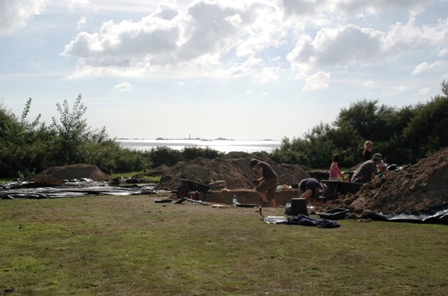Archaeologists at the University of Liverpool are investigating three island groups around Britain to further understanding of why, in approximately 4,000 BC, humans altered their lifestyle from hunting and gathering to farming the land.
Some scholars believe that this change occurred due to colonists from the continent moving into Britain, bringing farming and pottery-making skills with them, but others argue that the indigenous population of Britain adopted this new lifestyle gradually on their own terms.
To shed new light on the debate, archaeologists, in collaboration with the University of Southampton, are excavating three island groups in the western seaways and producing oceanographic models to understand what sailing across this area would have been like in 4,000 BC. The team will also construct a database of 5th and 4th millennium occupation sites.
The work aims to use evidence gathered from the seaways to answer significant questions about the processes and timing of the transition from a society that hunted wild animals to people that farmed the land as their primary means of survival.
Recent archaeological findings, such as what is believed to be French pottery in Scotland, have suggested that colonisation from the continent could be one possible explanation for this shift in lifestyle behaviour. Study has shown that the first colonist are likely to have arrived by travelling across the western seaways, but there has been very little excavation of the islands around this sea route to prove this theory, as previous research has tended to focus on the mainland rather than the seaways.
Dr Duncan Garrow, from the University’s School of Archaeology, Classics and Egyptology, explains: “Neolithic is a term used for the period in our past when the shift from hunting and gathering wild animals and plants to a farming lifestyle occurred. This change happened at different times throughout the world, beginning around 10,000 BC in the Middle East and around 4,000 BC in Britain. How this process occurred, however, is still very much debated.
“Archaeological findings, such as the bones of farm cattle from the 5th millennium BC and European pottery, and advances in radiocarbon techniques have given new life to the theory that European colonists settled in Britain and brought farming practices with them. To understand how possible this could have been, however, we need to turn our attention away from the mainland and towards the seas that form an important travel link between the islands around Britain.
“We are excavating on the Channel Islands, Isles of Scilly and in the Outer Hebrides, which form part of an important maritime zone that surprisingly has been given little scholarly attention in the past. We are constructing a database of all known 5th and 4th millennium occupation sites in and around each island group and starting a programme of radiocarbon dating to understand the chronology of activity within the western seaways.
“Our oceanographic work aims to explore the environmental context within which this transition took place and how seafaring activities impacted on people’s lifestyles. We hope that the environmental data will also be valuable to oceanographers and geographers for studying how the sea has changed over the centuries.”
The team will also make their findings available to school children and the general public through the development of a series of web resources, including a navigation game on prehistoric seafaring.
The study is funded by the Arts and Humanities Research Council (AHRC).
